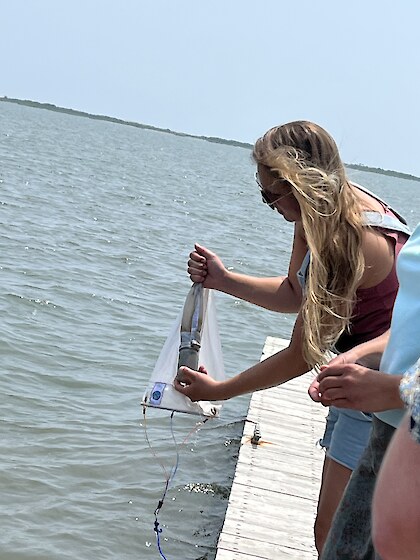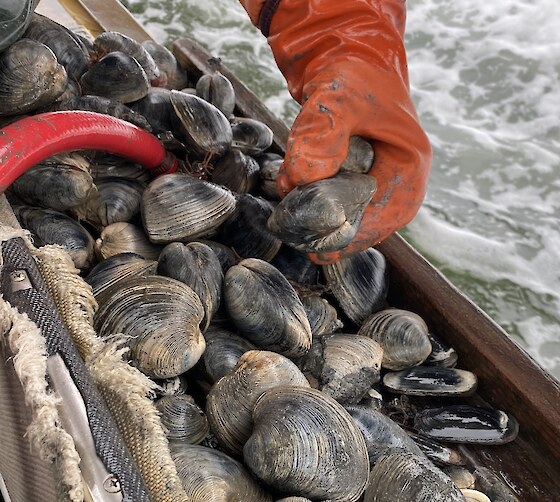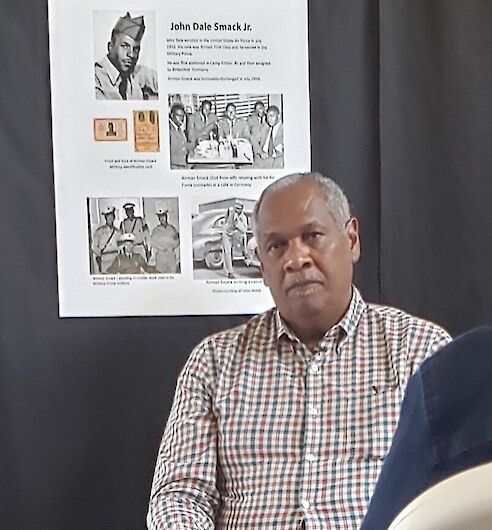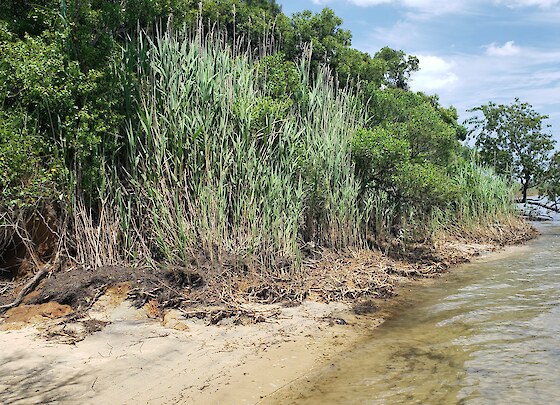Volunteers are crucial to NOAA's phytoplankton monitoring network

Program participants sample for phytoplankton like the diatom Pseudo nitzschia.
In summer 2023, MCBP’s science team partnered with the National Park Service as well as state, county, and local organizations, to recruit and train volunteers to participate in NOAA’s Phytoplankton Monitoring Network (PMN). The purpose of the PMN is to monitor phytoplankton species that could become harmful algal blooms (HABs).
This program provides hands-on learning opportunities for volunteers to engage in science and increases awareness of this environmental concern. HABs are predicted to become more prevalent with climate change, which is why monitoring the presence or absence of target species is critical to ensuring that our Bays remain healthy and safe.
WETLANDS retreat expands student horizons

Worcester County Public School students enjoy the WETLANDS retreat.
The Worcester Environmental Training, Leadership, and Stewardship (WETLANDS) 3-day student retreat is an immersive environmental science, leadership, and career exploration program. Local 9th grade students engage in hands-on scientific fieldwork, begin to think like leaders, and explore local conservation career opportunities. Students took a Coastal Bays boat ride, kayaked down the Pocomoke, and spoke to state park rangers, nature museum curators, boat captains, and conservation corps members. Student attendees were chosen by their high schools’ science teachers and guidance counselors based on environmental interest and personal need. The retreat is fully funded by MCBP with teacher and administrative support from Worcester County Public Schools.
Hard clam populations are improving in some regions of the Maryland Coastal Bays

Mechanical harvesting was banned in the Coastal Bays in 2008. Since then, hard clam populations have recovered across the bays, but the results are variable. Clam densities adjacent to the Ocean City Inlet—Isle of Wight and Sinepuxent bays—experienced strong increases to the point where they have exceeded or are close to baseline values from surveys conducted in 1952/53. The most recent MDNR shellfish survey found that Isle of Wight clam densities were the highest of the 70-year record for any of the Coastal Bays.
In contrast, densities in Chincoteague (historically the primary focus of the hard clam fishery) and Newport bays have been flatlined at levels well below their historic benchmarks for at least 30 years. The Assawoman Bay clam population is intermediate between the two groups, having increased since the ban but only to about half of historic densities. The lack of improvements in Chincoteague Bay, could be due to a number of factors such as brown tides and the rate of flushing.
Infrastructure investment benefits communities

The Bipartisan Infrastructure Law (P.L. 117-58), also known as the “Infrastructure Investment and Jobs Act of 2021” or “BIL” is a huge investment in water resources. It includes $50 billion to the U.S. Environmental Protection Agency (EPA) for water infrastructure, the single largest investment in water that the federal government has ever made. The BIL provides $132 million in funding for the 28 longstanding National Estuary Programs (NEPs), including MCBP, for fiscal years 2022–2026. This funding is evenly distributed to the NEPs, annually providing each with approximately $900,000 in BIL funds.
The funds were allocated to help stormwater retrofits in Berlin, design restoration of Hudson Branch and the Berlin Abbey Lane wetland, supplement DNR monitoring of brown tide, and restore the Assateague State Park shoreline south of the Verrazano Bridge. Other projects focused on education to foster environmental literacy and stewardship within our county schools, outreach to underserved communities, wetland assessment and monitoring, MCBP capacity building, developing the sand management strategy, and marsh degradation research. Community grants were given to Go Green OC, Freetown Education, Research and Cultural Center, ACT Coast Kids, and Germantown School.
The restoration of facilities such as the Germantown School provides community space and resources for arts and outreach. The National Park Service also received BIL funding to implement salt marsh restoration efforts and seagrass research that will occur in the Maryland Coastal Bays.

